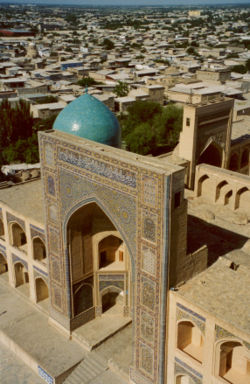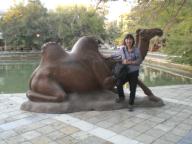|
|
|
|
|
|
|
|
|
|
|
|
Bukhara (2)Uzbekistan - Asia

Mir-i Arab madrasah The nation's fifth-largest city, it has a population of 237,900 (1999 census estimate). Bukhara (along with Samarkand) is one of the t wo major centres of Uzbekistan's Tajik population. The region around Bukhara has been inhabited for at least five millennia and the city itself has existed for half that time. Located on the Silk Road, the city has long been a centre of trade, scholarship, culture, and religion. Names Bukhara was also known as Bokhara in 19th and early 20th century English publications. History Introduction Bukhara has been one of the main centres of Iranian civilization during its history. Its architecture and archaeological sites form one of the pillars of the Persian history and art. The region of Bukhara was for a long period a part of the Persian Empire. The origin of its inhabitants goes back to the period of Aryan immigration into the region. Iranian Soghdians inhabited the area and some centuries later the Persian language became dominant among them. Encyclopedia Iranica mentions that the name Bukhara is possibly derived from the Soghdian Buxárak. Another possible source of the name Bukhara may be from "a Turkic (Uighur) transfer of the Sanskrit word 'Vihara'" (monastery), and may be linked to the pre-Islamic presence of Buddhism (especially strong at the time of the Kushan empire) originating from the Indian sub-continent, and to the presence of some Turkish rulers in the 6th Century. 
Bukhara The Trans-Caspian railway was built through the city in the late 19th century. The historic centre of Bukhara has been listed by UNESCO as one of the World Heritage Sites. It contains numerous mosques and madrassas.
All text is available under the terms of the GNU Free Documentation License (see Copyrights for details). About Wikipedia Disclaimers 2007 Site Index Back to Top Photos Index Thanks for coming, I hope you
have enjoyed it, will recommend
it to your friends, and will come
back later to see my site developing
and expanding.
|